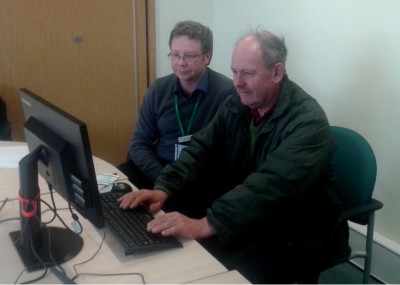Sue Buzzeo, Assisted Digital Project Manager for the Rural Payments service, talks about how they are putting in place help for farmers to claim their payments online.
We’ve been building a new digital service which will make it as easy as possible for farmers to claim their Rural Payments.
We recognise that some farmers, especially those living in remote rural communities, have concerns about getting online to make applications, either through lack of technical know-how or inability to access the internet. We have put in place help for those who need it through the Rural Payments Agency’s assisted digital service.
Digital by default and our user group
The Rural Payments Agency manages payments to around 100,000 farmers. These payments are part of the Common Agricultural Policy and the amounts paid depend on things such as the size of farmers’ land parcels, the crops they grow and a long list of other eligibility criteria. Users need to submit their claim by 15th May each year. Payments commence from 1st December once checks have been carried out.
Historically users have been able to choose how to submit their claim forms – either online or by paper. Over the past four years, through telephone and postal campaigns, we encouraged our users to switch from paper to digital. We made great progress with 70,000 (70%) of users submitting their claims online in 2014.
The new application service is 100% online, so we are in contact with those who aren’t online or who might need some help to make sure they have the appropriate support.
These are the five steps we took to achieve this support:
Step 2 – What does the service look like and who is eligible?
Step 3 – Assisted digital Outbound Calling Campaign
Step 4 – Assisted digital Support Centres
Step 5 – Assisted digital support from third parties
Step 1 – Who needs our help?
Before we could develop our assisted digital service we needed to define ‘who’ and ‘how’ many users needed help. By engaging early with the Government Digital Service, we found out about what had been done in other government services, what lessons could we learn and what pitfalls could we avoid.
We had a head start by being able to identify who had submitted paper applications in 2014 and looked at the following:
- Where were they located geographically?
- What was the broadband like in those areas?
- Was there any correlation between the number of paper applicants and poor broadband coverage?
- What was the size of the farms for the paper applicants?
- What was the age of the farmers of paper applicants?
- How could we define an assisted digital customer?
We defined four categories of users:
Can – those who have access to online capability and used it;
Won’t – those who have access to online capability but chose not to use it;
Can’t – those who do not have access to on-line capability through lack of computer and/or broadband and/or IT skills; and
Complex barriers – those who have added barriers such as a physical disability that would prevent them from going online even if they had access.

We were surprised to find no link between poor broadband coverage and numbers of paper applicants. We also discovered that a high number of paper applications came from smaller farms with smaller claims.
We knew that a number of our users were located in geographical areas that were hard to reach and where broadband was not available. We also knew that for many, being able to access the funds they were entitled to could make the difference to being able to stay in business or not.
In short we had to ensure that anyone eligible to claim would be supported and assisted in submitting their claim online irrespective of where they lived. The assisted digital service would be critical for many.
The biggest concern for our customers has been the transition to Online Services and the removal of paper forms. I feel that the RPA is supporting its customers through this transition and because of this, I have enjoyed being able to reassure people who feel nervous of computers and the internet.
*Quote from member of the Rural Payments Helpline
Step 2 – What does the service look like and who is eligible?
We first developed an assisted digital telephony service. Through this we engaged with users to understand what barriers they had to getting online and whether any of those barriers could be overcome. We encountered some users who acknowledged they were online but had no intention to submit their claim online in the future. These users are not eligible for assisted digital support so we carefully explained to them that if they did not use the new online service they would not be able to make future claims. These fell under our ‘won’t’ customer category.
It was clear from talking to users who were eligible for support that there were a number of ways they could get help.
These options included asking if users had access to help from:
- friends or family;
- business partners;
- intermediaries in the local area providing IT training or access to the internet;
- an agent they choose to use for professional support.
If the answer to all these options was ‘no’, then we would make an appointment for them to attend one of our Support Centres where they would sit with someone in a private room with access to a computer and broadband and get help with their online transactions. Unless there was a complex barrier that prevented a customer from using a computer, the customer would do as much as possible of the transaction themselves rather than us doing it for them.
Step 3 – Assisted digital Outbound Calling Campaign
Having established a process for assessing needs, our next step was to actively contact those users. Any user who had submitted a paper application in 2014, but who we knew had previously used other online services, we removed from our campaign. Our focus needed to be on the ‘cant’s’ and ‘complex barriers’.
We sent out around 13,000 letters, advising them that in the future all claims needed to be done online. We stressed that we understood this might be a daunting prospect and if anyone needed help with going online to let us know by returning an assisted digital pre-registration form.
Within two months of the mail out, we had received 3,780 requests for help. Our assisted digital users were being defined and we started ring them to talk about their needs.
I liked working on the outbound Call Campaign, as it felt good to be able to let people know that the RPA was supporting them through this transitional period and that we could offer one to one support if necessary.
*Quote from member of Rural Payments Helpline
Step 4 – Assisted digital Support Centres
We set up three trial Support Centres in Carlisle, Penrith and Exeter.

Users were given an appointment to get 1:1 help with their online transactions and claim submissions. These trials helped us understand how many appointments would be needed and how effective the support centre approach would be.
Currently we have fifty Support Centres, located in areas where we know there is the greatest assisted digital need. These are helping users and their feedback is enabling us to refine and improve the service. Although the demand for Support Centres is lower than anticipated at this point, we expect volumes to increase over the coming weeks and months.
Step 5 – Assisted digital support from third parties
There are a number of farming groups who are known to our users and who have historically provided local support in completing and submitting claims. Some users may choose to use an agent to submit their claims for them for a fee.
We have been working with these agents to give them an overview of the new service so they have the knowledge they need to help their clients submit their claims online. However, we will not be providing the agents themselves with assisted digital support.
Where appropriate, we have set up formal agreements with local farming groups outlining how we will support them in assisting their local members/farmers. We are running fortnightly webinars giving them training on the new service so they can cascade this training locally. Some will also provide 1:1 support sessions similar to those we offer at our Support Centres.
We are also trialling in two geographical areas using Citizen Advice Bureau offices to provide local support so they can assist their users online.
Following attendance at a training webinar this third party ran a local event and said:
….we have completed day 1 of registering with day 2 tomorrow. 19 farmers in total are doing 1:1 sessions with us. This was, as one farmer put it, time well spent! Although there were occasional challenges today, it has gone well. We are discussing arranging some more sessions and we do have a ‘drop in’ desk that farmers can come into the office and use it they have internet problems or just need support.
Summing up
So that is our journey to date which has covered;
- in-depth data analysis to identify our assisted digital users;
- on-going communication to ensure our users know we understand that for many there are barriers they need to overcome;
- clear processes that allow our teams to assess users’ needs and offer the best possible solution;
- the provision of a blend of support; and
- ensuring that we have on-going engagement with local third parties and organisations that our users trust to help them.
This journey is far from complete – we still have a lot to achieve ahead of the claim submission date of 15th May. We have a lot to learn from this and will be looking to share our experiences to help other services facing, or about to face, similar challenges.
Follow Rural payments on Twitter and don’t forget to sign up for email alerts
